Stoneleigh, Kenilworth, & Coventry
On Tuesday, we visited three different places: Stoneleigh Abbey, Kenilworth Castle, and Coventry Cathedral. The weather cooperated, making the day even more enjoyable.
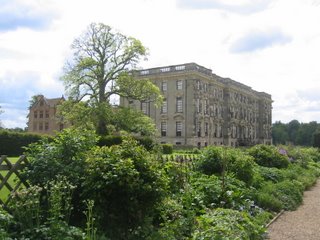
The building you see here is the main house at Stoneleigh Abbey, called the Georgian West Wing. We were able to tour this grand estate, which was the manorial home of the Leigh family and their heirs from the time of Henry VIII. In the manor house we saw the Saloon, the Library, Queen Victoria's bedroom, the Chapel, the Drawing Room, and many other elegant and restored rooms.

The gatehouse here dates to 1346 and is one of the few estate gatehouses still standing (from this time period) in the U.K.

The facade containes multi-colored stone: the lighter stone replaced original stone that was severely damaged a fire in 1959.

The Conservatory sits right along the River Avon. On the other side of the river is a beautiful field, famously occupied by American troops during WWII.

Here is a beautiful tree as seen from the Conservatory.

These are some of the original Abbey buildings, dating from 1155 when it was built as a Cistercian monastery. The old Abbey has now been made into 5 separate, private homes.
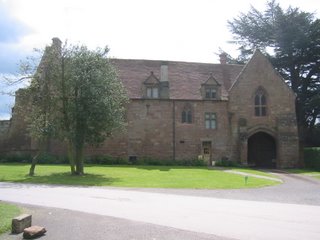 This is another picture of the beautiful gatehouse.
This is another picture of the beautiful gatehouse.
Stoneleigh Abbey sits a mile or so down a grand driveway, part of which you can see here. The trees line both sides: sheep graze in the fields on either side of the trees.

Believe it or not, this is the entrance to the stable yard. At one time the yard housed a livery of more than 100 horses.

Here's the main gate to the stable yard.
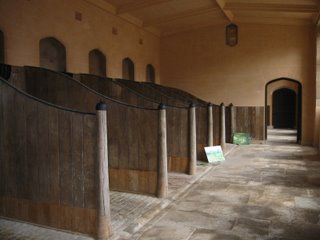
Each horse either had its own stall, like these pictured here, or shared a larger stall with one other horse. It was a very elegant setting.

This is the interior of the stable yard.
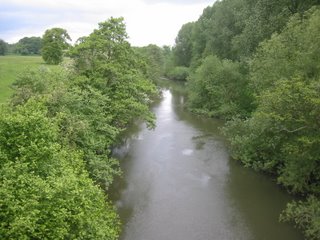
This picture was taken from the top of the bridge to Stoneleigh Abbey. The Avon was rerouted to suit the contours of the Abbey.

We then took a quick detour to see Kenilworth Castle. WOW! We walked along a public footpath to get the photos you see here.
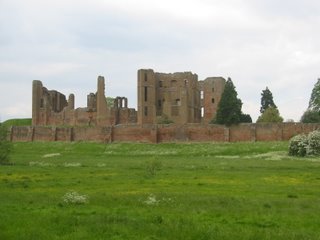
Kenilworth is one of the largest castle ruins in England.

Robert Dudley transformed Kenilworth from a medieval fortress into a great Tudor palace so he could entertain Elizabeth I when she visited him here in 1575.

As we drove through the town of Kenilworth, we had to take a picture of this great thatched house.
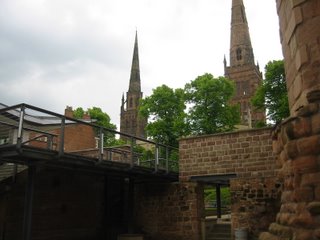
Our last stop was Coventry, home of the war-ruined St. Michael's Church and to the newer Coventry Cathedral. In this picture, the spire to the right is from nearby Holy Trinity Church, and the spire on the left is from the ruined St. Michael's.
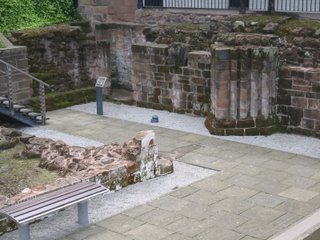
There have actually been three Cathedrals in Coventry's history. Here are the ruins of the first Cathedral of St. James which dates to the 11th century and was founded by Leofric and Lady Godiva.

This is St. Mary's Guildhall and is more than 650 years old. It served as the center of King Henry VI's court during the Wars of the Roses. What you see here is the facade on top of the main gate.

Here's the view once you walk through the gate. This is where Mary Queen of Scots was imprisoned in 1569.
 Here is the Great Hall, being set up for some special event.
Here is the Great Hall, being set up for some special event.
The walls of the Council Chambers were lined with these tapestries of many different family crests. The Guildhall still is the center of the government for Coventry.
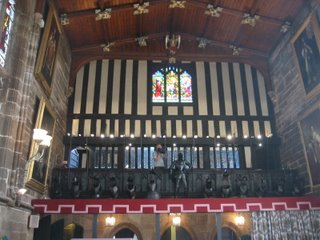
Here is a picture of the Minstrel's Gallery from the Great Hall.

This wonderful sculpture was situated in the small cloister of the Guildhall.

Here are the Tower and Spire of St. Michael's. The Cathedral suffered a direct hit in 1940 during the Blitz, and has been left in ruins since that time. Several windows still have shards of stained glass in them. It was very moving to see.

Here is the hexagonal-shaped choir of the old church.
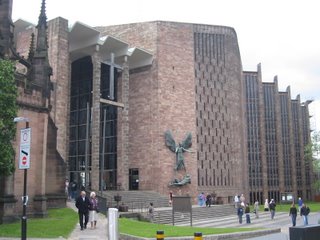
The new Coventry Cathedral, pictured here, is just off to the right of the ruined Cathedral (from this vantage). Unlike its predecessor, it is an extremely modern building, both inside and outside.

Here's a close-up of the sculpture on the wall outside Coventry Cathedral. It shows St. Michael defeating the Devil.
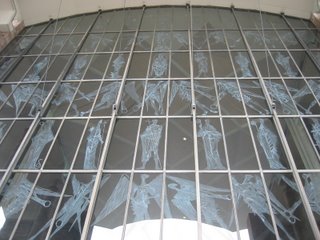
This is the West Screen, depicting angels and saints (etched into the glass). This window faces the ruined Cathedral.
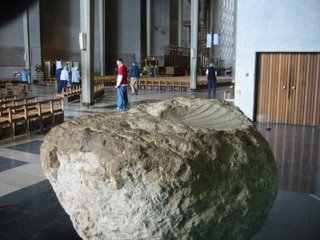
The Baptismal Font, pictured here, is carved into a boulder quarried from Bethlehem. Behind the font is an incredible Baptistry Window.
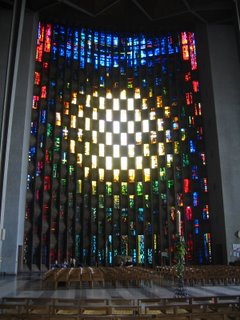
The colors in the window and its size are very impressive. You can get some perspective by looking for the font boulder at the bottom rear of this picture.

This sculpture is called the Plumb-Line; it represents the message of Amos 7:7-8: "Then the Lord GOD showed me this: he was standing by a wall, plummet in hand. ...the Lord said: See, I will lay the plummet in the midst of my people Israel; I will forgive them no longer." The sculpture was given to Coventry Cathedral by the people of Christ's Church...in CINCINNATI!!

Here is the Chapel of Christ the Servant. We loved the suspended crown of thorns above the altar.

Here is 'The Tapestry.' It's enormous: it covers the entire wall behind the main altar and depicts Christ in glory.
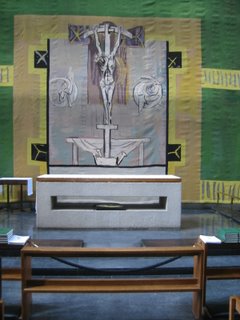
This smaller tapestry is situated immediately below the main one in the previous photo. It adorns the Lady Chapel behind the main altar.

Also in the Lady Chapel is this statue of the Virgin Mary gazing up at her Son on the cross.

These 5 tall and thin nave windows, running from floor to ceiling, are called the Windows of Life. Starting from the back of the church they symbolize birth, youth, maturity, old age, and the afterlife.

This small, simple, and brightly-lit chapel is the Millennium Chapel of the Stalingrad Madonna.

Eight of these 'Tablets of the Word' lined both sides of the nave of the Cathedral. They highlight quotations of Christ that summarize the Gospel messages of his teaching.

The beautiful Chapel of Unity effectively conveys its message of worldwide Christian unity in its long, narrow painted windows and marble floor tiles.

The floor was tiled with both the names and symbols of the four gospel writers and . . .

. . . representations of all seven continents.
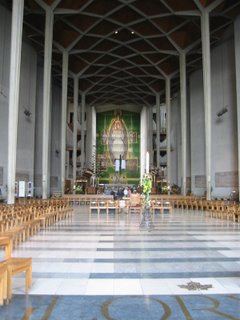
This picture gives a good view of the nave of Coventry Cathedral (and the size of The Tapestry).

This final view is of the exterior of the Unity Chapel of Coventry Cathedral.

0 Comments:
Post a Comment
<< Home